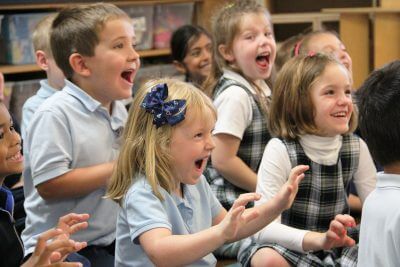May 26, 2017
 by Renee Wright, Mounds Park Academy Lower School Director
by Renee Wright, Mounds Park Academy Lower School Director
What makes a strong kindergarten program? How do you know what will be a good fit for your child? Should you find a program that stresses academics, play, or one that promotes both? Is a public neighborhood school the right choice or a private one with small classes?
There is no one right answer, and every family needs to base the decision on what works best for its individual circumstances and family values. Given our experience at Mounds Park Academy, a private PreK–12 school in Saint Paul, Minnesota, we believe that strong kindergarten programs are places where the following occur:
-
Joy abounds.
Kindergarten is a magical time. Students should be happy about being at school and excited to come home and share the news of their day. When you visit a kindergarten classroom, a sense of joy should exude from it because children are active, engaged, and having fun. At MPA, our teachers, administrators, parents, and students all use the word “joy” when describing kindergarten at MPA, joy that carries throughout the MPA experience.
-
Creativity thrives.
Kindergartners should be doing projects, not worksheets. Strong kindergarten programs will have students tackling creative projects that bring together emerging skills like writing, critical thinking, drawing, and reading. The best kindergarten programs will use an interdisciplinary approach to thematic projects and exercises as students are building their foundational academic skills. At MPA, we believe educational experiences are more authentic and of greater value when students learn through an interdisciplinary approach, even in kindergarten.
-
A love of learning flourishes.
A love of learning stems from joyful classrooms and joyful teachers. When kindergartners are engaged and having fun, learning becomes an exciting challenge to them. Strong kindergarten programs sprout this love of learning and cultivate it throughout the year, building upon the natural wonder and curiosity children possess at this age and never, ever stifling it.
-
Collaboration is commonplace.
Strong kindergarten programs promote collaboration at all levels: student to student, student to teacher, and teacher to parent. Children should be learning how to get along and work with their peers from all backgrounds through collaborative projects and learning. When you visit a kindergarten classroom, observe whether—and how well—the students are interacting with each other and their teacher. Also ask how teachers collaborate with parents to ensure clear communication, common goals, and a deep, mutual understanding.
-
Students shine.
When considering a kindergarten program, you should ask how teachers approach different learning styles and abilities, as well as differences in social and emotional development. In kindergarten, this varies widely, and it is critical for all students to have a positive experience no matter where they start. At MPA, small class sizes allow us to know our students exceptionally well and to individualize teaching and learning. The teachers are aware of the students’ strengths, opportunities for growth, and interests and strive to help them become the best versions of themselves.
When you’re looking at kindergartens for your child, ask yourself, “Would I want to spend a day here?” We find at MPA that many parents remark that they’d love to take a day—or month—and return to kindergarten, if they could go to MPA. Kindergartners learn by doing, and in our classes, the children are always actively participating, sharing ideas, working together, having fun, and exuding pure joy. Isn’t that how we all like to spend our days?!
To learn more about the kindergarten program at MPA, please contact the Office of Admission at admission@moundsparkacademy.org or 651-748-5577.